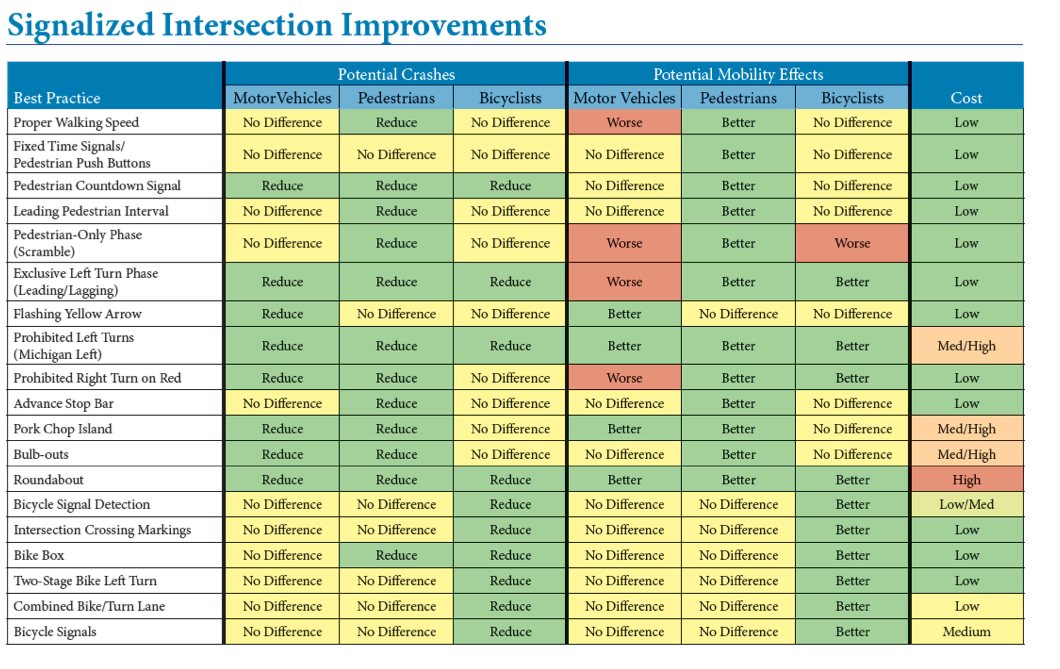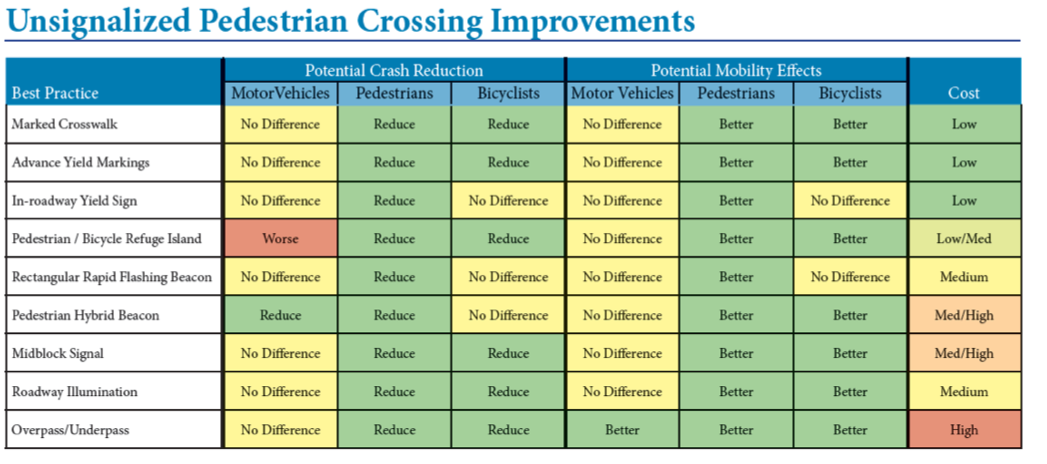MICHIGAN DOT
Executive Summary
Between 2005 and 2010, 6,948 pedestrians were injured in automobile crashes in the State of Michigan and 775 pedestrians were killed. During this same time, 5,500 bicyclists were injured and 147 bicyclists were killed in automobile crashes. While the number of crashes occurring nationwide is decreasing, automobile crashes continue to be one of the leading causes of death.
This research initiative combines the results of five reports to provide recommendations for improving the multimodal aspects of the MDOT transportation network through the use of practices, guidelines, and policies that MDOT engineers use to design and construct pedestrian, bicycle, and automobile facilities. Recommendations were based on information collected and analyzed in the following reports:
1. An analysis of crashes involving pedestrians and bicyclists in Michigan
2. A review and summary of current roadway improvements summarized by the Federal Highway Administration (FHWA) and their impacts on reducing crashes and their potential impact on mobility for all users
3. A case study analysis at five roadway improvement projects in Michigan and crash impacts at each location
4. A review of emerging design innovations provided by the National Association of City Transportation Officials (NACTO)
5. A summary report of the best design practices for pedestrian, bicycle, and automobile improvements in Michigan
This last report presents the improvements that were found to have the greatest utility in Michigan with respect to pedestrian and bicyclist safety and vehicle mobility. Created as a standalone document, Best Design Practices for Walking and Bicycling in Michigan is organized as a toolbox for planners and designers of pedestrian and bicycle facilities.
In addition, as part of the final report, a review was conducted of existing MDOT manuals, guidelines, and other publications that guide the planning and design pedestrian and bicycle facilities in Michigan. Recommendations were provided to facilitate the inclusion of these best practices in various MDOT roadway design documents.
Key Findings
Pedestrians are very vulnerable on MDOT highways. While crashes involving pedestrians account for less than 1% of crashes in Michigan, they account for 12.7% of Michigan fatalities. Young pedestrians ages 5 to 24 are more likely to be involved in crashes, whereas when pedestrians ages 55 and older are more likely to be killed when they are struck than younger pedestrians. Pedestrian crashes occur more often after dark than during daylight hours.
Key findings for bicycles included the finding that approximately 20% of fatal bicycle crashes occur on roadways with posted speeds between 25 and 30 mph. Bicycle crashes in Michigan occur most often between the hours of 3 and 6 pm.
Countermeasures that were associated with the greatest reductions in crashes included:
- Sidewalks reduce pedestrian crashes by 88%, while adding shoulders reduce pedestrian crashes by 70%
- Roundabouts show an overall decrease in all types of crashes by 35%, injury crashes by 76% and fatal crashes by 89%
- Road diets reduce all crashes anywhere from 14% to 49%.
- Raised medians reduce all crashes by 40%, and by as much as 69% at unsignalized intersections
- Pedestrian hybrid beacons were shown to have a 69% reduction in all crashes and a compliance rate of motorists yielding to pedestrians between 94-99%
- Bike lanes can reduce bicycle crashes by 50%
Mobility measurements were more difficult to assess. Most crash impact studies do not include mobility impacts, and educated assumptions were needed to include this information as part of the countermeasure discussions.
The case studies provided mixed results. The improvements for which before-and-after crash data or side-by-side crash results showed the largest overall changes were those that involved improvements that were implemented throughout an entire corridor. Improvements that were installed at intersection locations, such as pedestrian refuge islands or advance stop bars showed less clear results with respect to crashes.
Finally, all of the best practices that were recommended were either shown to reduce crashes involving motor vehicles, pedestrians, and/or bicyclists, or were shown to have no potential impact on one or more of these crash types. In some cases, a best practice was shown to have the potential to decrease mobility for one or two modes. This highlights the assertion that there continues to be tradeoffs between roadway user safety and mobility.
Three matrices are shown below that visually demonstrate the potential crash reductions, mobility effects and relative costs of each recommended practice. Some of the practices presented are still experimental and have not yet been adopted by MDOT as accepted practice. A fuller description of these special cases is provided in the full Recommended Practice Report.
Read Part 1 of report (PDF) here: Sharing the Road
PDFs for the remaining parts can be found here: Sharing the Road
About the MDOT
www.michigan.gov/mdot
“Providing the highest quality integrated transportation services for economic benefit and improved quality of life.”
Tags: Cycling, Michigan, MichiganDOT, Pedestrians, safety, Vehicle Mobility








 RSS Feed
RSS Feed